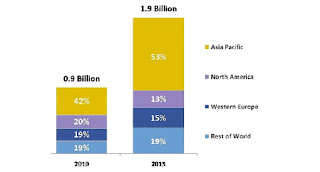Yesterday I received a magazine from my bank called Investment, in the magazine there was an article “Social Network are good for the Society”[1]. In the article the author came to the conclusion, that due to a survey on social media, people on the Social media are for 96%, only sharing content and information which could be described as small talk or chit chat. The survey described that only 4% of the content on FaceBook is "serious" content.
- Is there models which can help us choose as a B2B enterprise the best Social Media tools towards our costumers?
- So if you are not selling consumer products you will not be able to use Social Media towards costumers?
- Even though FaceBook is the biggest of the Social Media content “spreaders” it will not work for B2B enterprises to get a dialog with their costumers?
First before explaining and answering the questions and all the virtues of Social Media and the use towards B2B costumers, I do understand the author of the article in “Investment” and his point of describing Social Media as to much small talk. Looking into what my children are using FaceBook fore is mainly chit chatting with each other and expression views on everything and nothing. Some could say that this kind of collaboration is not something which enterprises addressing the B2B market should use time and money?
But you have to take into consideration that a large majority of these chit-chatters are your costumers enjoying the social media in their spare time for something else than business. But be aware they will remember you seeing you and your products and services - if you are there.
There are no doubt that you as an enterprise addressing the B2B market need to be selective of which types of Social Media you choose[2]. You as an enterprise has to select what will do the best for your business and what your social media advocates get most out of.
So even if your are not selling consumer products you have to have a voice on the social media platform you can even find surveys telling you that B2B enterprises are investing even more heavily in social Media as a part of the overall marketing strategy, than consumer related companies. Some major players even start to take their employees into education session learning employees how to listen and participate in costumer communication and that the employees are personally responsible for their own branding, as well as the enterprise branding.
You can find cases where companies in the pharmaceutical sector, get their products “tried out” by users using FaceBook groups to communicate about their experiences with a product – this happened to Novo Nordisk who found that one of their new insulin products could be used for something else than just diabetes It could be used as a obesity restricts.
Another challenge you will have to work out is the lack of measurement tools, which will give C-level management a ROI, which is measurable in raw figures.[3]
Even though Social Media has a hard time to deliver results which is easy to be quantified, social media is moving so fast forward that the real risk is to stay out. It is not a matter of you as an enterprise can afford to implement a B2B social media presence into your marketing strategy, it is a matter of you can afford to stay out - and as the author of the article in investment said Social Media is here for good!
[1] Danske Bank Investment May 2011 page 32
